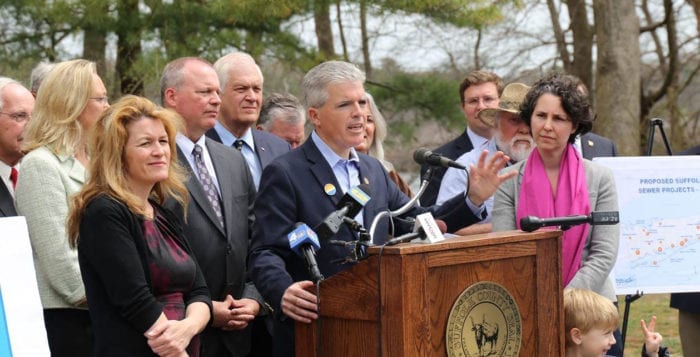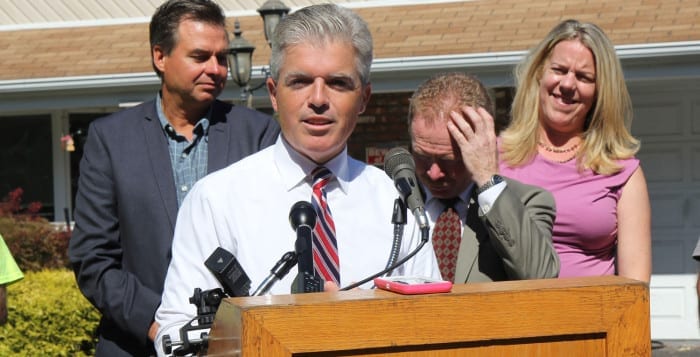Voters in Suffolk County could soon be faced with deciding whether or not they’d like to pay more for their water to improve its quality.
Suffolk County Executive Steve Bellone (D) brought a big crew of environmentalists and lawmakers with him on Monday to announce his plan to address nitrogen pollution in drinking and surface water across the region by charging an additional $1 per 1,000 gallons of water. If it receives the state’s blessing, the plan could go before Suffolk County residents in a referendum vote in November.
The proposal would establish what Bellone called a water quality protection fee, which would fund the conversion of homes from outdated septic systems to active treatment systems, the county executive said. He estimated the $1 surcharge would generate roughly $75 million in revenue each year to be solely dedicated to reducing nitrogen pollution — and still keep Suffolk County’s water rates nearly 40 percent lower than the national average.
“What we have seen over the decades is a decimation of our surface waters and the latest numbers showing disturbing trends in the groundwater,” Bellone said. “Clearly, the overwhelming source of that nitrogen pollution is from us. We have 360,000 homes on old septic and cesspool systems.”
Bellone said the proposal would supplement similar efforts from New York Gov. Andrew Cuomo, who established a $383 million investment in expanding sewers in Suffolk County. The governor launched the Center for Clean Water Technology at Stony Brook University and provided funding for the Long Island Nitrogen Action Plan over the past several years to help create recurring revenue for clean water infrastructure.
Richard Amper, executive director of the Long Island Pine Barrens Society, endorsed the county proposal as Suffolk County rising to the occasion. He referred to nitrogen as the chief culprit behind the county’s water pollution, coming mostly from wastewater.
“If we don’t take this step, we are putting our collective future at serious risk.”
“Two-thirds of it in Suffolk County is coming from 360,000 homes with 5,000-year-old technology,” he said Monday. “We know what to do about it. We’ve studied it. The public is satisfied that … investment had to be made in studying it. Now it’s time for action.”
Roughly 90 percent of the population in Nassau County operates under an active wastewater treatment system through connections to sewage plants. But in Suffolk County, there are more than 360,000 individual cesspools and septic systems — representing more unsewered homes than in the entire state of New Jersey — that are more likely to release nitrogen into the ground and surface water.
Marc Herbst, executive director of the Long Island Contractors’ Association, said the initiative was necessary for the future of the environment.
“It is about building a wastewater treatment system that ensures the environmental integrity of our county, the underlying foundation of our economy and the value of our homes,” he said. “The Long Island Contractors’ Association supports this proposal because if we don’t take this step, we are putting our collective future at serious risk. It is as simple, and crucial, as that.”
The state must authorize the proposal in order for it to be placed on a ballot in November.
State Assemblyman Steve Englebright (D-Setauket) — a known environmental activist — said the measure would do wonders for the state’s water supply.
“We’re really looking at an opportunity to correct some deficiencies that could, if left uncorrected, unhinge our economy, which is based upon people bathing and recreating in our coastal waters, fishing and otherwise enjoying our waters,” he said. “For the first time, we are pulling a program together that integrates both our fresh water and saltwater in one protection initiative, and that is very significant.”
The Town of Brookhaven held a public hearing last Thursday night before adopting a low-nitrogen zone for various properties 500 feet from major water bodies, like Setauket and Port Jefferson harbors, requiring all new development or expansions to install low-nitrogen septic systems rather than standard cesspools. Brookhaven Supervisor Ed Romaine (R) endorsed the county plan as well for not only increasing the momentum away from nitrogen pollution, but also for providing voters with the choice.
“I applaud County Executive Bellone for his leadership in advancing this plan to restore water quality across this county and, more importantly, for proposing that the people of Suffolk decide whether the plan should be implemented,” he said. “Though some may disagree with it, no other elected official has offered a plan to reverse nitrogen pollution on this scale.”






